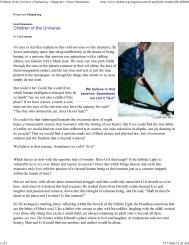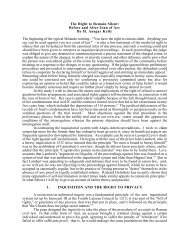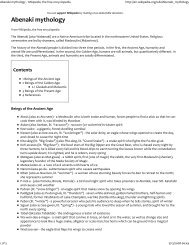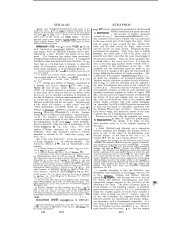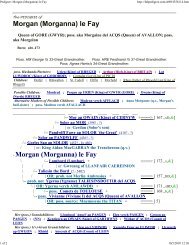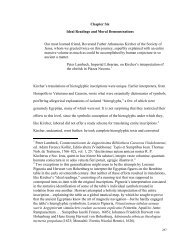Encylodaedia Biblica; a critical dictionary of the literary, political and ...
Encylodaedia Biblica; a critical dictionary of the literary, political and ...
Encylodaedia Biblica; a critical dictionary of the literary, political and ...
Create successful ePaper yourself
Turn your PDF publications into a flip-book with our unique Google optimized e-Paper software.
PHCENICIA P H CE N I C I A<br />
The Greek genealogic poetry provided <strong>the</strong> Phcenicians with The long prevailing derivation <strong>of</strong> <strong>the</strong> name Phcenicia from <strong>the</strong><br />
an eponym-Phcenix king <strong>of</strong> Sidon,-who was identified with a Egyptian Punt (Lepsius), a l<strong>and</strong> that was located by older<br />
Cretan god <strong>and</strong> hero Phoinix, whose daughter Europa, origin- writers in S. Arabia, is quite impossible. The Egyptian Punt<br />
al1.y a Bceotian <strong>and</strong> Cretan goddess, thus became a Sidonian is <strong>the</strong> incense-bearing Somali-coa5t in Africa whose inhabitants<br />
princess. For what reason Cadmus, <strong>the</strong> son <strong>of</strong> Agenor <strong>the</strong> (Eg. Punti, Lepsius wrongly PUM) have dothing whatever to<br />
eponym <strong>and</strong> founder <strong>of</strong> <strong>the</strong> Cadmeia <strong>of</strong> Thehes, was made <strong>the</strong> do with Pceni, Qoiurrss.<br />
bro<strong>the</strong>r <strong>of</strong> Phcenix we do not know: he had at any rate, The Phoenicians <strong>the</strong>mselves reckoned <strong>the</strong>ir l<strong>and</strong> to<br />
nothing to do with Phmnicia. At a still later'time Cadmus<br />
became <strong>the</strong> bro<strong>the</strong>r <strong>of</strong> Europa which resulted in <strong>the</strong> latter's Canaan (for <strong>the</strong> evidence, see CANAAN, I), <strong>and</strong> with<br />
becoming <strong>the</strong> daughter <strong>of</strong> Aienor, <strong>and</strong> her fa<strong>the</strong>r Phcenix perfect justice. They are, in fact, a branch <strong>of</strong> <strong>the</strong><br />
becoming her bro<strong>the</strong>r. A fur<strong>the</strong>r analysis <strong>of</strong> this legend does Canaanites, which, at <strong>the</strong> beginning <strong>of</strong> <strong>the</strong> time<br />
not belong here; cp Meyer, (;A 2933 The Latin Pcenus is historidly known to us (about 1500 B.c.), had occupied<br />
prohahly ra<strong>the</strong>r a contraction <strong>of</strong> ' Phoinix' than an older form<br />
without <strong>the</strong> suffix.<br />
many places on <strong>the</strong> coast, while <strong>the</strong> intermediate region<br />
Kaft, which frequently occurs in <strong>the</strong> Egyptian inwas<br />
still in <strong>the</strong> h<strong>and</strong>s <strong>of</strong> an Amorite population (cp<br />
scriptions <strong>of</strong> <strong>the</strong> New Empire, passed for a long time<br />
AMORITES, CANAAN).^<br />
as ano<strong>the</strong>r old name for Phoenicia; %OW~K~ is thus<br />
One evidence <strong>of</strong> this is supplied by <strong>the</strong> Phcenician<br />
rendered in <strong>the</strong> hieroglyphic text in <strong>the</strong> bilingual decree<br />
language, which differs only dialectically from <strong>the</strong> o<strong>the</strong>r<br />
<strong>of</strong> Canopus. There are cogent reasons, however, for<br />
Canaanite dialects known to us (Hebrew <strong>and</strong> Moabite) ;<br />
rejecting this view, <strong>and</strong> seeking for Kaft outside <strong>the</strong><br />
see WRITING. Though it exhibits in many instances a<br />
younger vocabulary (e.g., in>, to give, ih, God), it has<br />
Semitic world, perhaps in Cilicia (cp CAPHTOR, 4).<br />
The name may be connected with <strong>the</strong> enigmatical name<br />
frequently retained older grammatical forms <strong>and</strong> words<br />
JAPHETH [q.~.], <strong>and</strong> <strong>the</strong> Gk. 'I&mros (<strong>the</strong> name <strong>of</strong> a<br />
which in Hebrew have become obsolete.2<br />
Cilician god, in Steph. Byz., S.V. "AGaua <strong>and</strong> 'Ayx~dXq).<br />
In fact it was simply <strong>the</strong> difference between <strong>the</strong><br />
In <strong>the</strong> OT <strong>the</strong> Phcenicians generally are named<br />
conditions <strong>of</strong> life <strong>of</strong> <strong>the</strong> coast-l<strong>and</strong> <strong>and</strong> those <strong>of</strong> <strong>the</strong><br />
nm*x, Sidonians; for instance Itoba'al, king <strong>of</strong> Tyre,<br />
interior, that gradually separated <strong>the</strong> Phcenicians from<br />
is called ' King <strong>of</strong> <strong>the</strong> Sidonians' in I K. 1631 ; cp<br />
<strong>the</strong>ir fellows who had settled far<strong>the</strong>r inl<strong>and</strong>-much in<br />
<strong>the</strong> same way<br />
Judg.1061~ 187 rK.5~0<br />
as <strong>the</strong> Dutch were severed from <strong>the</strong> o<strong>the</strong>r<br />
111533 zK.2313; <strong>and</strong> in<br />
<strong>the</strong> genealcgy <strong>of</strong> <strong>the</strong> nations, Gen. 101s (cp Judg. 33=<br />
N. Germans. Their different historical development,<br />
Josh. 134-6). In <strong>the</strong> same way King Hiram 11. <strong>of</strong><br />
<strong>and</strong> above all <strong>the</strong> occupation <strong>of</strong> Palestine by <strong>the</strong><br />
Tyre is called in an inscription pnx ~SD, ' King <strong>of</strong> <strong>the</strong><br />
Israelites, enlarged <strong>the</strong> breach.<br />
Sidonians,' <strong>and</strong> on coins <strong>of</strong> <strong>the</strong> time <strong>of</strong> Antiochus IV.<br />
As to <strong>the</strong> age <strong>of</strong> <strong>the</strong> Phcenician tawns we possess no<br />
Tyre is called ojlx ow, ' <strong>the</strong> metropolis <strong>of</strong> <strong>the</strong> Sidonians<br />
information. for <strong>of</strong> course no historical value attaches to<br />
'<br />
-Le., Phcenicians. In Homer <strong>the</strong> Phoenicians are<br />
3. Commence- <strong>the</strong> statement <strong>of</strong> Africanus (in Syn<strong>of</strong>ten<br />
called ZdJvm (Il. 6290 Od.<br />
merit <strong>of</strong> <strong>the</strong> cellus, 31) that <strong>the</strong> Phcenicians said<br />
15118 4618), <strong>the</strong>ir<br />
l<strong>and</strong> Zdovlq (11.6291 Od. 1328s) ; but %OiVlK€S is also<br />
<strong>the</strong>y had a historical tradition reaching<br />
history.<br />
back for 20.0oo years. Far more<br />
found (IZ. 23 743 f: ; Od. 13 272 14 288 j? 15 415 8).<br />
Both names occur toge<strong>the</strong>r in <strong>the</strong> celebrated verses<br />
moderate is <strong>the</strong> assertion -<strong>of</strong> Herodotus (244) that,<br />
concerning Menelaus' w<strong>and</strong>erings (Od. 4845 ). The<br />
according to native tradition, Tyre <strong>and</strong> its temple <strong>of</strong><br />
Hercules had been founded 2300 years previouslyname<br />
<strong>of</strong> <strong>the</strong> town Sidon is found in Od. 15425. From<br />
<strong>the</strong> fact that Sidon, not Tyre, is mentioned, we must<br />
Le., about 2730 B.C. Even in this, however, no one<br />
not draw <strong>political</strong> conclusions as some have done;<br />
will venture to find a real tradition. According to<br />
through <strong>the</strong> influence <strong>of</strong> <strong>the</strong> ethnic name 'Sidonian'<br />
ano<strong>the</strong>r statement <strong>the</strong> founding <strong>of</strong> Tyre was much later.<br />
<strong>the</strong> name <strong>of</strong> Sidon was familiar to <strong>the</strong> Greeks at an<br />
Justin (182) relates that for a long time after <strong>the</strong>ir<br />
earlier time than that <strong>of</strong> Tyre, although <strong>the</strong> latter was<br />
immigration (see above, § 2) <strong>and</strong> <strong>the</strong> founding <strong>of</strong> Sidon<br />
<strong>the</strong>n much <strong>the</strong> more important. Roman poets, too,<br />
<strong>the</strong> Phcenicians lived on <strong>the</strong> coast, but that being <strong>the</strong>n<br />
overcome<br />
frequently we ' Sidonius' (as a synonym for ' Pcenus ')<br />
(ezpugRati) by <strong>the</strong> king <strong>of</strong> Ashkelon, <strong>the</strong>y<br />
in <strong>the</strong> sense <strong>of</strong> ' Phcenician' (cp Ovid, Fasf. 3108 etc. ).<br />
took to <strong>the</strong>ir ships, <strong>and</strong> founded Tyre <strong>the</strong> year before<br />
A precise definition <strong>of</strong> Phcenicia can hardly be given.<br />
<strong>the</strong> fall <strong>of</strong> Troy. To what year <strong>the</strong> latter event is<br />
assigned here cannot be ga<strong>the</strong>red from <strong>the</strong> context ; but<br />
The boundaries assigned by Herodotus, Scylax, Straho,<br />
when we find in Men<strong>and</strong>er <strong>of</strong> Ephesus, <strong>the</strong> historian<br />
Pliny, <strong>and</strong> Ptolemy vary greatly. The last-mentioned<br />
(v. 154) reckons Phoenicia from <strong>the</strong> Eleu<strong>the</strong>rus to <strong>the</strong><br />
<strong>of</strong> Tyre, a Tyrian era that begins in <strong>the</strong> year 1198-7<br />
B.c.<br />
brook Chorseas S. <strong>of</strong> Dor. Accepting this view, we<br />
(Jos. Ant.viii.31, 5 62, c. A$. i. 18. 8 126; <strong>and</strong><br />
may describe Phcenicia as <strong>the</strong> coast-l<strong>and</strong> at <strong>the</strong> foot <strong>of</strong><br />
<strong>the</strong>nce Eus. a. Ah. 745) we may regard it as almost<br />
certain that this is <strong>the</strong> epoch intended. Now it was at<br />
Lebanon <strong>and</strong> <strong>of</strong> <strong>the</strong> hill-country <strong>of</strong> Galilee down to<br />
this time that <strong>the</strong>re occurred <strong>the</strong> great movement among<br />
Carmel. Marathus <strong>and</strong> Arados, however, lie N. <strong>of</strong><br />
<strong>the</strong> nations which resulted in <strong>the</strong> occupation <strong>of</strong> Ashkelon<br />
this territory, <strong>and</strong> in <strong>the</strong> S. <strong>the</strong> border is fluctuating<br />
<strong>and</strong> arbitrary. The impossibility <strong>of</strong> fixing a definite<br />
<strong>and</strong> <strong>the</strong> neighbouring places by <strong>the</strong> PHILISTINES (q.~.)<br />
boundary line between <strong>the</strong> Phcenicians <strong>and</strong> <strong>the</strong> o<strong>the</strong>r<br />
<strong>and</strong> also affected <strong>the</strong> Phcenician cities (see 5 5). It<br />
is possible, <strong>the</strong>refore, that <strong>the</strong> statement <strong>of</strong> Justin<br />
Canaanites is specially obvious in <strong>the</strong> more remote<br />
<strong>and</strong> Men<strong>and</strong>er's era preserve a recollection <strong>of</strong> <strong>the</strong>se<br />
times before <strong>the</strong> settlement <strong>of</strong> <strong>the</strong> Israelites <strong>and</strong> <strong>the</strong><br />
Philistines. The limits above assigned correspond<br />
events. On <strong>the</strong> o<strong>the</strong>r h<strong>and</strong>, <strong>the</strong> date may rest simply<br />
roughly to <strong>the</strong> name Zuhi<br />
on some chronological combination no longer known<br />
by which <strong>the</strong> Egyptians at<br />
to us. It is, at any rate, historically certain from<br />
<strong>the</strong> time <strong>of</strong> <strong>the</strong>ir conquests designated <strong>the</strong> Phcenician<br />
<strong>the</strong> Amarna tablets that, in <strong>the</strong> fifteenth century, <strong>the</strong><br />
coast (cp WMM, As. II. BUY. 1768). The origin <strong>of</strong><br />
isl<strong>and</strong>-city <strong>of</strong> Tyre was already extant, <strong>and</strong> one <strong>of</strong> <strong>the</strong><br />
this name is unknown.<br />
most powerful cities <strong>of</strong> Phcenicia.<br />
Herodotiis relates that <strong>the</strong> Phcenicians, as <strong>the</strong>y <strong>the</strong>m-<br />
Whe<strong>the</strong>r <strong>the</strong> lists <strong>of</strong> Phcenician kings mentioned by later<br />
selves declare, were originally settled upon <strong>the</strong> ' Red ' I .<br />
writers (Tatian, adv. Crrpc. 37 ; Porphyry ap. Eus. Prrp). a.<br />
a. origin <strong>and</strong> Sea, <strong>and</strong> came <strong>the</strong>nce to <strong>the</strong> Syrian x. 9 12, from Sanchuniathon) possessed any value for <strong>the</strong> older<br />
nationality. coast (1 I 7 89): The ' Red ' Sea is <strong>of</strong><br />
period, is uncertain. If <strong>the</strong>re were any historical lists going<br />
course <strong>the</strong> Indian Ocean. more esDeci- 1 This is probable on <strong>the</strong> following ground. As late as <strong>the</strong><br />
ally <strong>the</strong> Persian Gulf. It would seem <strong>the</strong>refore-that last millennium B.c., new Phcenician towns were planted upon<br />
<strong>the</strong> nor<strong>the</strong>rn foot <strong>of</strong> Lebanon-Fbtrys under Hiram I. <strong>of</strong> Tyre,<br />
<strong>the</strong>re once was a Phoenician tradition which, like that Triplis probably not until <strong>the</strong> time <strong>of</strong> <strong>the</strong> Persians. How to<br />
in <strong>the</strong> OT, made <strong>the</strong>ir ancestors immigrants from account for <strong>the</strong> existence <strong>of</strong> a (much mutilated) Phcenician<br />
Babylonia.<br />
inscription in N. S ria two hours W. <strong>of</strong> Zenjirli (Winckler<br />
AOfi 1305), is not ccar. The inscription belongs to <strong>the</strong> tim;<br />
* The story was afterwards fur<strong>the</strong>r embellished : support for about 750-700 B.C.<br />
it was found in <strong>the</strong> names <strong>of</strong> <strong>the</strong> isl<strong>and</strong>s Tylos <strong>and</strong> Arados <strong>of</strong> a C Stade 'Erneute Priifung des zwischen dem Pbcen. u.<br />
Bahrein on <strong>the</strong> Persian Gulf (Straho, xvi. 3 4 zJ). On <strong>the</strong> story Heb. %esteheAde Venv<strong>and</strong>tschaftsgrades,' in Morgenl<strong>and</strong>isch<br />
<strong>of</strong> Trogus Pompeius, see SODOM AND GOMORRAH.<br />
30. rschungcn, 1874.<br />
3731<br />
3732



